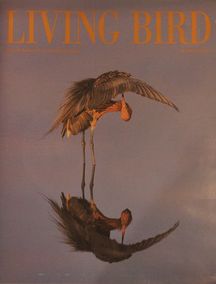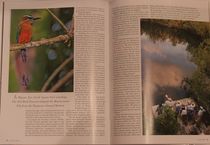Reviewed by Grant McCreary on November 6th, 2007.
Living Bird is a quarterly magazine for members of the Cornell Lab of Ornithology. This high-quality magazine should be given consideration by birders the world over.
The first thing you will notice about this magazine is that it looks like few others. Full-page photographs adorn both the front AND back covers. There is only minimal, unobtrusive text on the front so as not to take away from the usually stunning photograph. High-quality, fairly stiff, paper is used for the cover. The internal pages are printed on better paper stock than typical high-circulation periodicals.
The 46 pages in this magazine can be broken down as follows:
- Greetings from Sapsucker Woods
- Letters
- BirdNews
- Columns
- Feature Articles
The “Greetings” is a brief message from the editor-in-chief on the table of contents page. “Letters” is one page of letters from readers, and “BirdNews” is a single one-page news article.
The meat of each issue is the columns and featured articles. There have been 5 columns that I have encountered thus far:
- Flying Field, by Mel White
- In the Field, by Jack Connor
- Spotlight, by David S. Wilcove
- Picture Perfect, by various authors
- The Catbird Seat, by Pete Dunne
Of these, Dunne’s is the only one that appears in every issue. Two of the remainders are also printed, for a total of three columns in each issue. “Flying Field” features birding locations, “Spotlight” focuses on conservation, and “Picture Perfect” deals with photography. I’m not sure if there’s a running theme to Jack Connor’s “In the Field”. All of these are very well written and informative. For instance, I’m not a photographer but I’ve still found the “Picture Perfect” columns interesting. These columns occupy 2-5 pages each.
Dunne’s “The Catbird Seat” is a short one-page column that appears on the last page of each issue. If you’ve ever read any of his columns then you know what to expect here. And if you haven’t, I don’t think I could do justice to them. Just trust me and immediately go read one (or preferably all) of the collections of his stories (you can find them here). His column actually makes me look forward to the end of every magazine.
About half of each issue is comprised of three or four featured articles. Here is a small sample:
- King of the Western Sage (Greater Sage-Grouse)
- In the Land of the Maya (birding the Yucatan Peninsula)
- In Search of Haiti’s Birds
- Digiscoping Revisited
- Name that Warbler (a fascinating discussion of a hybrid New World warbler documented by a bird bander in 2006)
- Serengeti Safari
- The Birds of Vadim Gorbatov (a Russian wildlife artist)
- A Celebration of Shorebirds (Copper River Shorebird Festival in Cordova, Alaska)
From the titles you can see that this magazine has a world-wide focus and that a variety of topics are covered. However, there is one topic that has been conspicuously absent: bird identification. This magazine seems to have focused on other aspects of birds and birding, and has left ID for others. While I greatly enjoy learning more about identification, the lack of it here in no way diminishes my enjoyment of this title. But if you’re looking primarily for ID information, then you should look instead to the many other publications dedicated to that topic.
Beautiful color photographs profusely illustrate each installment, along with paintings where appropriate.
The only way to subscribe to this magazine is by becoming a member of the Cornell Lab. Membership starts at $35 ($45 for those outside the United States), and includes this magazine, a separate newsletter (BirdScope, also published quarterly), and some various discounts. This is a great magazine, but even so it is hard to recommend at $8.75 per issue! However, there are other reasons for joining the lab. Your membership fees will help the lab carry out research, education, and conservation programs. You’re probably familiar with some of the projects that they sponsor such as Project FeederWatch, the Great Backyard Bird Count, and eBird. As an added bonus for those in the US, your entire membership fee is tax deductible.
Given all of these benefits, joining the lab is an easy recommendation.
If you’d like to check it out for yourself first, many articles have been archived on the lab’s website.
Disclosure: I get a small commission for purchases made through links in this post.






I may be showing my age, but I much preferred the original Living Bird, published annually and stuffed with scientific literature. The stuff that appears in Living Bird today is just pretty pictures and fluff articles for the masses. The cynical might see it as little more than a PR tool for recruiting membership in the CLO.
I’ve only been a member for less than 2 years, so I’m not aware of the change you mentioned. I’m curious about it – when did it happen? Did they just completely reimagine/retarget the publication?
Do you know what the print circulation of Living Bird is?
Sue, sorry for the late reply. I took a look around the Cornell Lab’s website, but I couldn’t find the number of members they have.